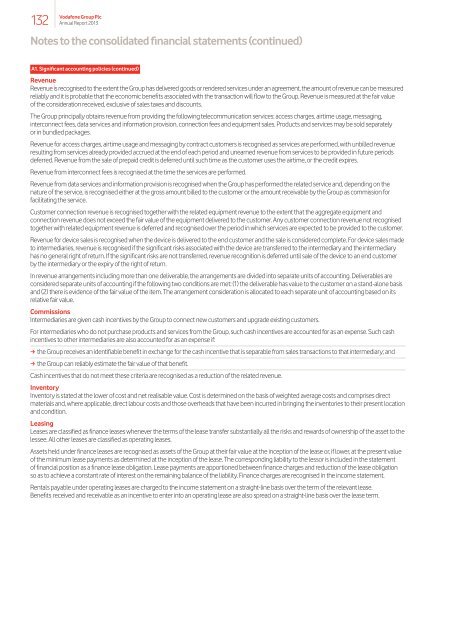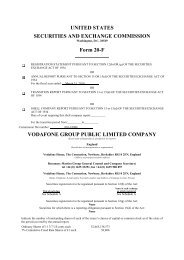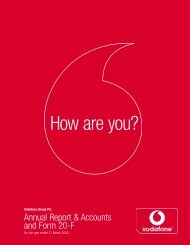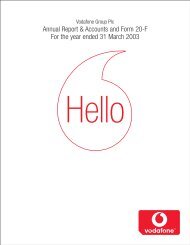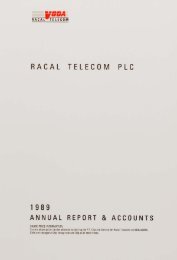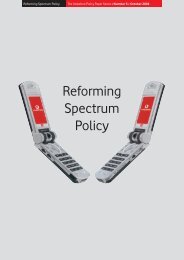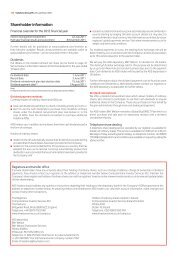The way ahead? - Vodafone
The way ahead? - Vodafone
The way ahead? - Vodafone
Create successful ePaper yourself
Turn your PDF publications into a flip-book with our unique Google optimized e-Paper software.
132<br />
<strong>Vodafone</strong> Group Plc<br />
Annual Report 2013<br />
Notes to the consolidated financial statements (continued)<br />
A1. Significant accounting policies (continued)<br />
Revenue<br />
Revenue is recognised to the extent the Group has delivered goods or rendered services under an agreement, the amount of revenue can be measured<br />
reliably and it is probable that the economic benefits associated with the transaction will flow to the Group. Revenue is measured at the fair value<br />
of the consideration received, exclusive of sales taxes and discounts.<br />
<strong>The</strong> Group principally obtains revenue from providing the following telecommunication services: access charges, airtime usage, messaging,<br />
interconnect fees, data services and information provision, connection fees and equipment sales. Products and services may be sold separately<br />
or in bundled packages.<br />
Revenue for access charges, airtime usage and messaging by contract customers is recognised as services are performed, with unbilled revenue<br />
resulting from services already provided accrued at the end of each period and unearned revenue from services to be provided in future periods<br />
deferred. Revenue from the sale of prepaid credit is deferred until such time as the customer uses the airtime, or the credit expires.<br />
Revenue from interconnect fees is recognised at the time the services are performed.<br />
Revenue from data services and information provision is recognised when the Group has performed the related service and, depending on the<br />
nature of the service, is recognised either at the gross amount billed to the customer or the amount receivable by the Group as commission for<br />
facilitating the service.<br />
Customer connection revenue is recognised together with the related equipment revenue to the extent that the aggregate equipment and<br />
connection revenue does not exceed the fair value of the equipment delivered to the customer. Any customer connection revenue not recognised<br />
together with related equipment revenue is deferred and recognised over the period in which services are expected to be provided to the customer.<br />
Revenue for device sales is recognised when the device is delivered to the end customer and the sale is considered complete. For device sales made<br />
to intermediaries, revenue is recognised if the significant risks associated with the device are transferred to the intermediary and the intermediary<br />
has no general right of return. If the significant risks are not transferred, revenue recognition is deferred until sale of the device to an end customer<br />
by the intermediary or the expiry of the right of return.<br />
In revenue arrangements including more than one deliverable, the arrangements are divided into separate units of accounting. Deliverables are<br />
considered separate units of accounting if the following two conditions are met: (1) the deliverable has value to the customer on a stand-alone basis<br />
and (2) there is evidence of the fair value of the item. <strong>The</strong> arrangement consideration is allocated to each separate unit of accounting based on its<br />
relative fair value.<br />
Commissions<br />
Intermediaries are given cash incentives by the Group to connect new customers and upgrade existing customers.<br />
For intermediaries who do not purchase products and services from the Group, such cash incentives are accounted for as an expense. Such cash<br />
incentives to other intermediaries are also accounted for as an expense if:<br />
a the Group receives an identifiable benefit in exchange for the cash incentive that is separable from sales transactions to that intermediary; and<br />
a the Group can reliably estimate the fair value of that benefit.<br />
Cash incentives that do not meet these criteria are recognised as a reduction of the related revenue.<br />
Inventory<br />
Inventory is stated at the lower of cost and net realisable value. Cost is determined on the basis of weighted average costs and comprises direct<br />
materials and, where applicable, direct labour costs and those overheads that have been incurred in bringing the inventories to their present location<br />
and condition.<br />
Leasing<br />
Leases are classified as finance leases whenever the terms of the lease transfer substantially all the risks and rewards of ownership of the asset to the<br />
lessee. All other leases are classified as operating leases.<br />
Assets held under finance leases are recognised as assets of the Group at their fair value at the inception of the lease or, if lower, at the present value<br />
of the minimum lease payments as determined at the inception of the lease. <strong>The</strong> corresponding liability to the lessor is included in the statement<br />
of financial position as a finance lease obligation. Lease payments are apportioned between finance charges and reduction of the lease obligation<br />
so as to achieve a constant rate of interest on the remaining balance of the liability. Finance charges are recognised in the income statement.<br />
Rentals payable under operating leases are charged to the income statement on a straight-line basis over the term of the relevant lease.<br />
Benefits received and receivable as an incentive to enter into an operating lease are also spread on a straight-line basis over the lease term.


